Looking for tips to get a better return on your investment?
With a few tweaks, you can increase the chances that your Facebook ad campaigns will succeed.
In this article, you'll discover four ways to improve your Facebook ad campaigns.
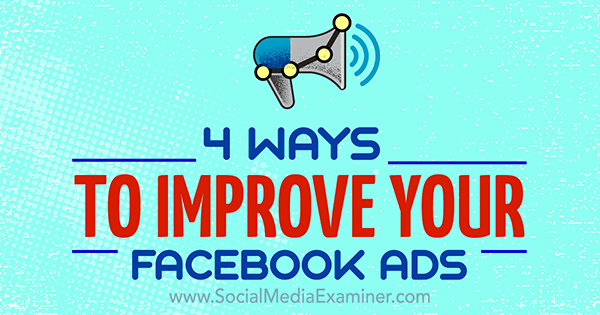
#1: Monitor Frequency Before Making Changes
Often businesses will create Facebook ad campaigns with beautiful imagery and landing pages, only to pull them down after a few days because of low conversions.
This is understandable, because it's scary when you put money into something and you're not sure whether it's working. The truth, though, is that you'll rarely see success right away with a Facebook ad campaign.
It's important to test a lot of ad variations. This means variations in audiences, imagery, ad copy, and more. When you do testing, be sure to give the campaign time for it to return real data about what's working. Facebook is also generally very good at optimizing your ads for you as your audience starts to engage.
For example, with the following ad campaign, it took four weeks to get these costs per click.

Run an ad for at least a week before you start to make any drastic changes to the campaign (although this depends on your budget). The larger your campaign budget, the quicker you'll receive the data that helps you make informed changes to the campaign.
A lot of this comes down to understanding your campaign goals. Before running a campaign, it's always useful to have an idea of what you're willing to spend per acquisition. That way, you can judge how your ad is doing initially. If the ad is way off the mark, you might opt to make changes sooner. If it's not far off, you'll find that the price will drop over time as you tweak.
As mentioned above, pulling campaigns too soon is potentially a mistake. On the other hand, running ads for too long can be detrimental to your campaign for two reasons: ad fatigue and ad blindness. Ad fatigue happens when your audience sees your ads too many times and starts to ignore them. Or worse, people hide the ads from their news feed or report them. No matter what they do, it will negatively impact your return on investment and your ads will be less effective.
As humans, we're exposed to thousands of promotional messages every day. This can often mean when we go onto Facebook, we simply don't see the ads there. We become blind to them. That's why it's important to test different ads.
The good news is that it's relatively easy to ensure that ad fatigue and blindness don't happen. The best way to gauge this is to look at your frequency.
Get World-Class Marketing Training — All Year Long!
Are you facing doubt, uncertainty, or overwhelm? The Social Media Marketing Society can help.
Each month, you’ll receive training from trusted marketing experts, covering everything from AI to organic social marketing. When you join, you’ll also get immediate access to:
- A library of 100+ marketing trainings
- A community of like-minded marketers
- Monthly online community meetups
- Relevant news and trends updates
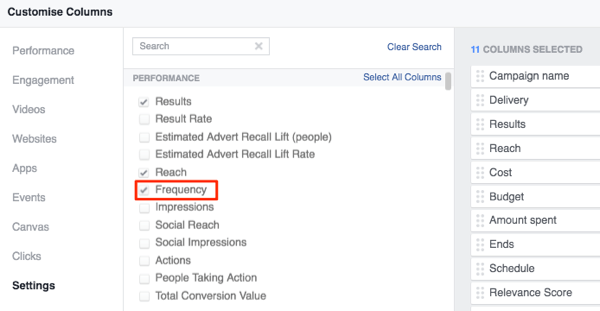
To find your feedback score in your Facebook Ads Manager, click the Columns drop-down menu and select Customize Columns. You'll find Frequency under Performance.
Frequency is the average number of times that your ad was shown to each person. It's calculated by the number of impressions for your ad divided by the number of unique users. You might try to make changes to your campaigns when the frequency is around 3 to 5.
#2: Improve Targeting With Audience Insights
One of the biggest and most costly mistakes you can make with Facebook ads is not using Audience Insights.
Audience Insights reveals a huge amount of data about your audience. The tool was originally designed to help advertisers target their ads more effectively, but it's also commonly used by people who simply want to find out more about their audience. This information can be helpful even if you're not advertising.
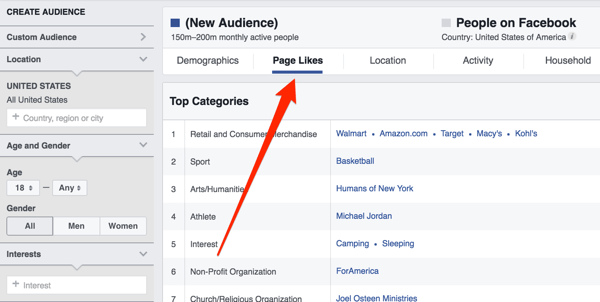
To access Audience Insights, go into your Ads Manager and look for Audience Insights under Plan.
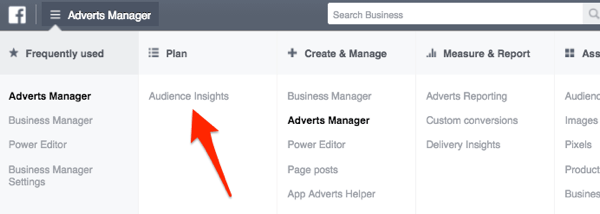
Say, for example, that you're selling a new fishing rod. You'd probably assume that targeting “fishing” as an interest is a good idea when creating a Facebook ad. After all, you want to target people who like fishing.
To find out whom you'd actually be targeting with “fishing” as an interest, go into Audience Insights and type in your target interest of “fishing.” Then click the Page Likes tab to discover more about this audience.
In the top section, you can see the pages that your selected audience likes. In other words, when you target “fishing,” you're targeting people who like these Facebook pages.
When creating a Facebook ad, you want to make sure the pages shown here are all relevant. However, for the fishing example, this isn't the case. You can see that a lot of pages are related to hunting and trucks. Why would we want to target your fishing products to people who are into hunting or trucks, but not fishing?
So when you're creating an ad, rather than typing in generic terms like “fishing” into the targeting section, use Audience Insights to explore whom you're actually targeting by doing that.

Discover Proven Marketing Strategies and Tips
Want to go even deeper with your marketing? Check out the Social Media Marketing Podcast! Publishing weekly since 2012, the Social Media Marketing Podcast helps you navigate the constantly changing marketing jungle, with expert interviews from marketing pros.
But don’t let the name fool you. This show is about a lot more than just social media marketing. With over 600 episodes and millions of downloads each year, this show has been a trusted source for marketers for well over a decade.
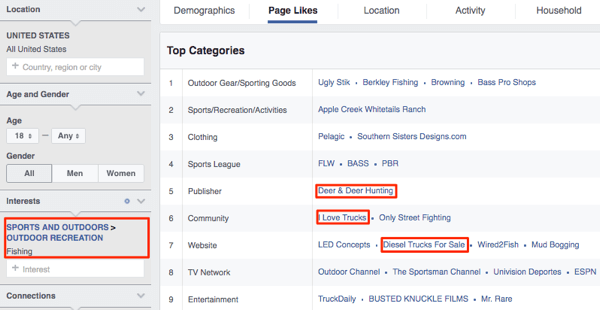
With the fishing example, you can see some specific fishing pages in the Page Likes section. Make a note of all of the relevant pages you see. Then place these pages individually into Audience Insights and see what page likes are revealed. You'll find pages where the likes are all super-relevant to the term you typed in.
Once you compile a list of 5 to 10 relevant interests, create your ad. Now you know your ad will be seen by people who actually have a keen interest in what you're selling. Save your audience in Audience Insights and simply select it in the targeting section when creating your ad.
#3: Send People to Optimized Landing Pages
The landing page of your Facebook campaign can make or break its success. Consider these two scenarios:
First, you're scrolling through your news feed and you see an ad that catches your eye. It's promoting a product that will help you solve a problem. You click on the ad and it takes you to the company's homepage.
Second, an ad catches your eye, but this time when you click on the ad, you're taken to a specific landing page that gives you more context for what the ad was about. It tells you everything you need to know and provides you with case studies on people who have used the product and had positive results.
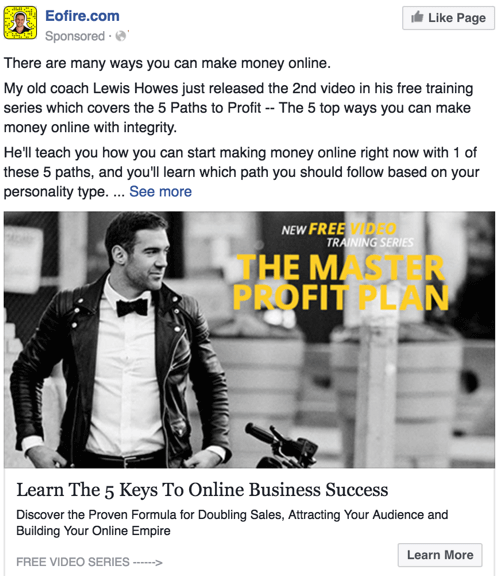
In scenario 1, you'll end up wasting time searching the company website for the product you saw in the ad. Guess what? As consumers, we don't have the attention or time to do that, so we'll likely bounce off the page and forget about the offer, no matter how good it looked.
In scenario 2, you're taken to a page that provides you with more context, tells you exactly what you're going to get, and gives you some real case studies on people who have used it.
Which scenario do you think will convert better? You can see that sending people to a landing page specific to your offer is crucial.
The most important thing on your landing page is the headline. Write a headline that is clear and concise, and tells visitors what they're getting in less than seven seconds. The best way to do this is to skip the benefit and instead mention the outcome (of downloading/buying the product/service).
The page should also include a subtitle to provide more context to the headline.
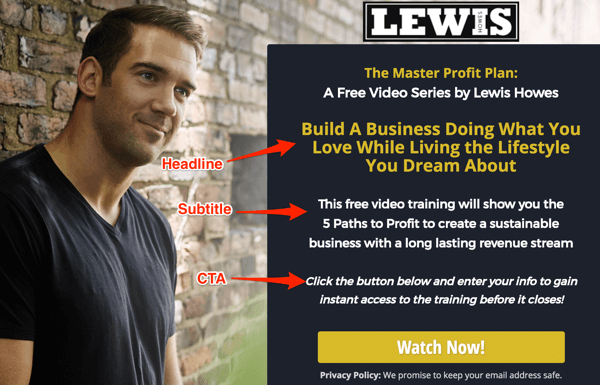
Remember to also include social proof on your landing page. It can be anything from a picture of you with logos of publications in which you've been featured to testimonials and case studies from people who have used your product or service.
Finally, include a loud and clear call to action. Be sure to place it “above the fold.”
It's important to ensure your landing page is optimized for mobile. Ninety percent of visitors will come via mobile, so a nice-looking desktop landing page that's not mobile-friendly is pointless.
#4: Test Different Copy Lengths
There's a common misconception that short copy ads perform better than long copy ads. In fact, it's a misconception that any post on Facebook performs better when it has shorter copy. Though the theory is good, in reality, it's not the case.
With all Facebook ads, it's important to test, because one industry and audience might react differently than others.

When you're writing your ad copy, you need to understand whom you're writing the ad for. Write a message that will resonate with your target audience.
First write a longer piece of ad copy, including a bit of storytelling. Then take the copy and cut it down to something shorter.
You should include a call to action in the ad. You're required to choose a call to action when you create your ad, but it's also important to have one in the ad itself. It can be something like “Click here to find out more” or “Click here to download our free ebook.”
Take the guesswork out of it for visitors. Tell them what action you want them to take!
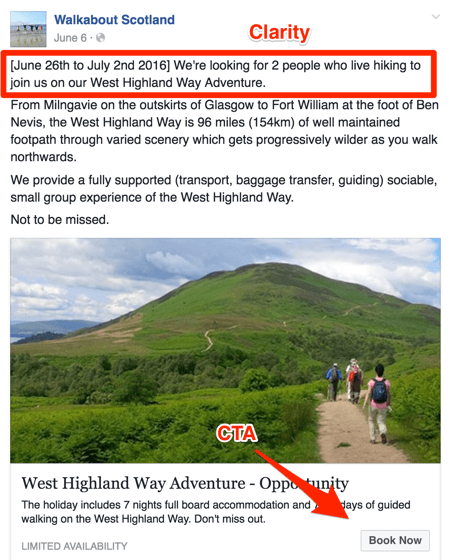
On Facebook, when users scroll through their news feed, the image is what stands out. The image catches their attention initially and encourages them to go on to read the ad copy.
After you've hooked them with your image, you want to spark some sort of emotional reaction or give them a reason to take the desired action.
Conclusion
With Facebook advertising, there's no single key to success. There's no one thing you can do that's guaranteed to work. It's a continual process of testing and optimizing. Over time, you'll begin to notice trends and see things start working. That's when you can scale campaigns up until they're profitable.
What do you think? Have you tried any of these tactics to improve ad campaign success on Facebook? Do you have some tips to share? Please let us know in the comments below!
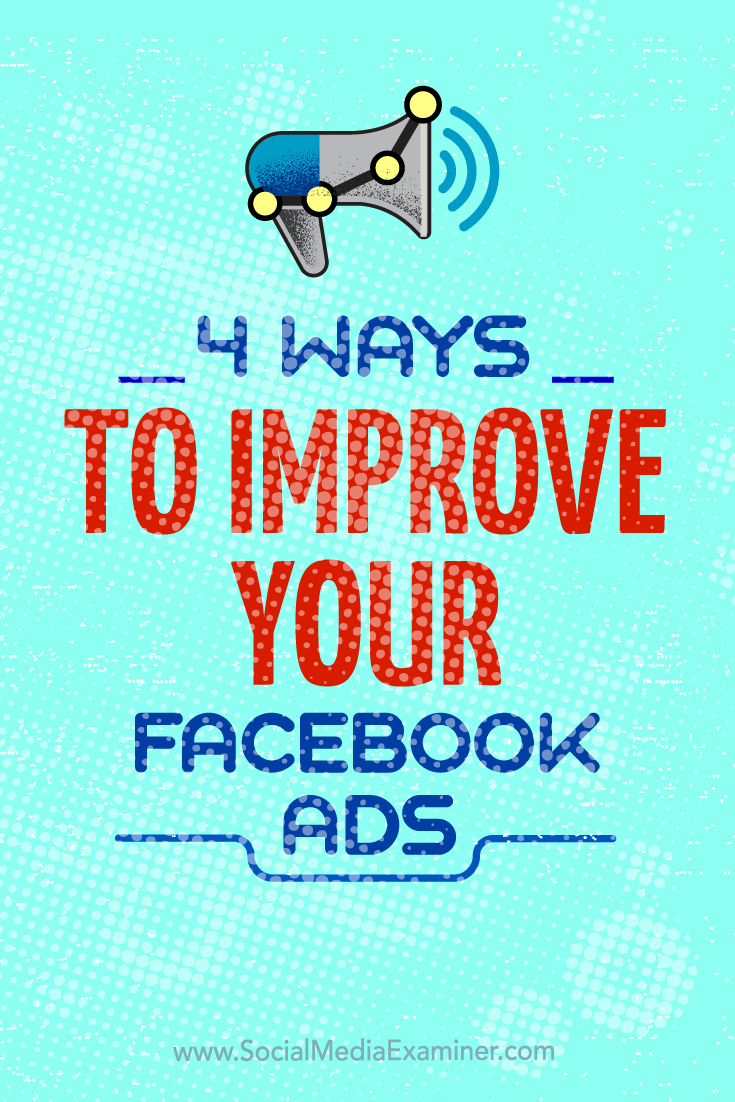
Attention Agency Owners, Brand Marketers, and Consultants

Introducing the Marketing Agency Show–our newest podcast designed to explore the struggles of agency marketers.
Join show host and agency owner, Brooke Sellas, as she interviews agency marketers and digs deep into their biggest challenges. Explore topics like navigating rough economic times, leveraging AI, service diversification, client acquisition, and much more.
Just pull up your favorite podcast app, search for Marketing Agency Show and start listening. Or click the button below for more information.


